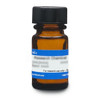Ozenoxacin is a quinolone antibiotic with bacterididal activity against Staphylococcus aureus and Streptococcus pyogenes, the causal agents of impetigo. Ozenoxacin also has activity against some bacteria that are resistant to fluoroquinolones. The compound is a non-fluorinated quinolone, with a pyridinyl group at C-7. It is an inhibitor of bacterial DNA gyrase A and topoisomerase IV.
Ozenoxacin is soluble in DMSO.
| Mechanism of Action |
Ozenoxacin, along with other quinolones, inhibits bacterial DNA gyrase A and topoisomerase IV, enzymes needed for bacterial DNA replication. |
| Molecular Formula | C21H21N3O3 |
| Spectrum |
Ozenoxacin has potent activity against Gram-positive bacteria including MRSA, MSSA, MSSE and MRSE (methicillin-resistant Staphylococcus aureus, methicillin-susceptible Staphylococcus aureus, Methicillin-susceptible Staphyloccus epidermidis, and Methicillin-resistant Staphyloccus epidermidis) respectively. It also has activity against some Gram-negative isolates. |
| Microbiology Applications |
Ozenoxacin was 3 to 321-fold more active than other quinolones against quinolone-susceptible and quinolone-resistant Gram-positive bacteria. It has in vitro activity against methicillin-resistant Staphylococcus aureus (MRSA) and Staphylococcus epidermidis (MRSE). |
| Eukaryotic Cell Culture Applications |
Studies on Ozenoxacin metabolism have demonstrated that the compound is minimally metabolized in human hepatocytes. Interleukin (IL-6, IL-8) production by human epidermal keratinocytes stimulated by heat-killed Cutibacterium acnes was significantly inhibited by Ozenoxacin at 1-30 μg/ml. This suggests that Ozenoxacin has an anti-inflammatory activity (Tabara et al, 2020). |
| References |
López Y et al (2013) In vitro activity of Ozenoxacin against quinolone-susceptible and quinolone-resistant Gram-positive bacteria. Antimicrob. Agents Chemother. 57(12):6389-6392 PMID 24080666 López Y et al (2014) In vitro selection of mutants resistant to Ozenoxacin compared with levofloxacin and ciprofloxacin in Gram-positive cocci. J. Antimicrob. Chemother.70(1):57-61 PMID 25261416 Tabara K et al (2020) Anti-inflammatory effects of ozenoxacin, a topical quinolone antimicrobial agent. J. Antibiot. 73:247-254 |


